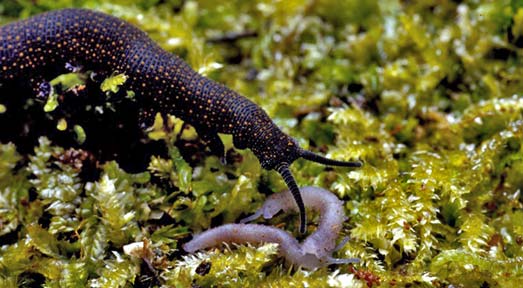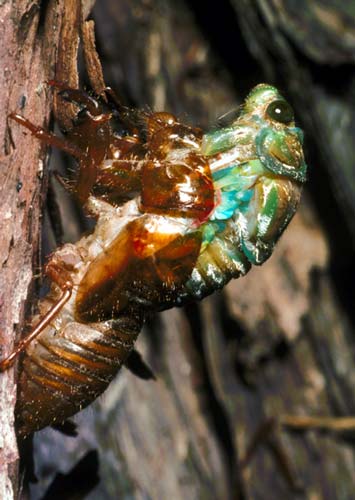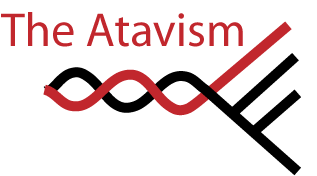Tuesday, September 29, 2009
Where did you get that preposterous hypothesis
From time to time you find yourself disagreeing with something you read in a scientific paper. Perhaps you don't think the authors have applied a method correctly or ,more often, you don't think that the results they present are enough to justify the claims made in the their discussion or their university PR department's breathless press release. You don't often end up wondering if the third most prestigious journal in the world might have an April Fool's day issue. But what else is one to think when confronted with an opening paragraph like this one from a recent paper [1]:
I reject the Darwinian assumption that larvae and their adults evolved from a single common ancestor. Rather I posit that, in animals that metamorphose, the basic types of larvae originated as adults of different lineages, i.e., larvae were transferred when, through hybridization, their genomes were acquired by distantly related animals.
Got that? The author thinks that animals with distinctly different larval forms (caterpillars and butterflies, tadpoles and frogs, veligers and marine snails...) don't descend from a single ancestor that had a simple life history and later developed a two-stage strategy. Rather, Donald Williamson thinks that metamorphosing organisms are chimeras - hybrids between two distinct lineages in which the two parental genomes have reached a compromise such that one parent gets to run what we call the larval form and the other oversees the adult.
This is certainly not a mainstream idea, but the paper I'm talking about was published in the Proceedings on the National Academy of Science (PNAS), one of the most prestigious scientific journals that there is, Williamson must have some good data to support his idea right? Well, no. Williamson's entire case appears is that he finds it really really hard to imagine metamorphosis evolving in gradual steps and, besides, some larval forms look quite a lot some other organisms. Williamson does distinguish himself from other pedlars of what Richard Dawkins has named the "argument from personal incredulity" by at least providing a specific hypothesis to test: modern insects with 'caterpillar' larvae (butterflies, beetles, ants, wasps, bees, files...) descend from an 'accidental' mating between a flying insect and an onychophran (no illustration of this process is provided).
 Peripatoides novaezealandiae, a wide spread New Zealand endemic onychophoran and young, photo © Te Ara
Peripatoides novaezealandiae, a wide spread New Zealand endemic onychophoran and young, photo © Te Ara
Onychophorans (which we usually call 'peripatus' in New Zealand) are part of that admittedly large list of creatures that can be called "David's favourite animals" so before we hang Williamson's preposterous hypothesis out to dry I'm going to have to subject you to a little bit of cheer-leading. This is not the first time that onychophorans have been the subject of woolly evolutionary thinking. Since they are likely related to some of the most spectacular cambrian fossils people have called them "living fossils" and you'll even sometimes hear it proposed they represent a *shudder* "missing link" between arthropods (insects, crustaceans, spiders...) and annelids (earthworms and their kin). Which is all a great shame because it diverts attention from the fact the onychophorans are nocturnal hunters which crawl through the leaf litter on hydro-statically inflated legs in pursuit of small invertebrates which they immobilise with a sticky glue they spray from their mouths in order to let them inject digestive enzymes into their stricken prey and suck the resulting soup from its lifeless body. That's the sort of thing people ought to know about it.
What about Williamson's "larval transfer" idea? Is this a case, like Wegner and continental drift or Bretz on ice ages, in which science needs some outré thinking to get itself out of a rut that is holding it back? Hardly.
Insect metamorphisms isn't that hard a problem

An adult cicada emerging from its last nymphal molt © Te Ara
.Just how complete metamorphosis of the sort you see in butterflies evolved is a genuinely difficult and, as such, interesting question. But it's one that Williamson clearly hasn't bothered to read about. If he had he would've found a lovely review from Deniz Ereyilmaz2 who traces the history of the problem and makes a case that larvae are effectively free living embryos (an idea that was articulated by Harvey (of the circulatory system) and later used by Darwin in the 6th edition of The Origin to reply to contemporary criticism that his theory couldn't explain metamorphosis). Specifically, the idea is that the holometabolous insects (the ones that undergo complete metamorphosis) evolved from direct developing insects like cicadas and grasshoppers. In these insects the final stage of embryonic development is called a pronymph, in most species the pronymph molts into a mini-adult (called a nymph) before it hatches but a few species actually hatch as pronymphs. Ereyilmaz and the few entomologists that have tackled this question in recent years think holometabolous insects descend from species in which the pronymph hatched and then became able to feed. From there the development of the pronymph stage was extended while nymphal development (which usually proceeds as small changes accrued in each of several molts) was progressively squeezed into one step, which we now call pupation (like a caterpillar's cocoon).
There is some nice genetic evidence that something like that process has happened. One of the genes required to start the metamorphosis process is called broad, mutants that can't produce functional broad protein fail to pupate. Insects like cicadas and grasshopers that don't undergo complete metamorphosis also have copies of broad but in these insects broad is expressed at each nymphal molt - consistent with the idea pupation in holometabolic insects corresponds to nymphal molt in direct developing insects.
The evolution of complete metamorphosis remains an interesting question (if you are want to learn more Christopher Taylor has deeper look at it than I've given here) but the sort of path laid out above - the gradual addition of multiple, relatively small changes to the existing insect life cycle is surely orders of magnitude more likely than two genomes being thrown together and, somehow, deciding to regulate two complete separate developmental programmes as well as the entirely new process of breaking down the first genomes animal before development of the second one can begin?
Complete metamorphosis doesn't use two sets of genes
Williamson also asks 'genomocists' to search for distinct genomes within the DNA sequence of holometabolous insects. We don't need a complete genome to know that the same genes are being used in the development of adults and larvae. People have been studying the genetic basis of development in Drosophila (which my taxonomic pedantry won't allow me to call fruit-flies) for at least 20 years - all Williamson needed to do to check his hypothesis against the evidence was open an undergraduate textbook. Had he done that he would have seen, in one tirivial example, that the that patterning of the adult wing in Drosphila requires the genes hedgehog and wingless (geneticists usually name genes after what loss of function mutants look like ) both of which are also vital to defining the polarity of the segments formed in embryonic development. We've also know since at 1997 [3] than oncychophorans and insects inherited their hox genes, (the genes that lay out the basic body plan in animals) from a common ancestor that lived before the two groups split up - and the holometabolic insects we've looked at only have one set of hox genes.So why is this in PNAS?
OK, so Williamson has his answer to the problem of metamorphosis and no evidence is about to sway him from it. But he's not asking for his nonsense to be taught in public schools or anything - he's just a harmless crank. The question is why was his idea afforded space in one of the most prominent scientific journals instead of being expressed in the standard media for cranks - self published pamphlets or a huge single page website made with Mircrosoft FrontPage and featuring five different colours of text interspersed with clip-art and presented on a yellow background. Well, until very recently there where two ways to be published in PNAS, you could submit an article to the editorial office in the normal way or you could have a member of the National Academy of Sciences 'communicate' your article - which still required peer review but the whole process, including picking the reviewers, was overseen by the communicating member. In this case the communicating member was Lyn Margulis who richly deserves to be a member of the academy for providing the evidence then championing the very unorthodox idea that mitochondria (of which I've spoken before) descend from free living bacteria that long ago formalised a symbiotic union they'd fallen into with an ancestor of us Eukaryotes. That very strange idea has now been accepted by pretty much everyone that has an opinion on the matter but since that triumph Margulis has fallen into what Jerry Coyne( world famous geneticist, new atheist and cat blogger) calls Big Idea Syndrome. A lot of people who discover some interesting and important wrinkle in a prevailing theory get it into their minds that their discovery is actually driving force behind an entire field of study. In Margulis's case this syndrome manifests itself in an unwavering belief that all the interesting questions in biology can be answered with symbiosis and "acquired genomes" while modern evolutionary biology and its fascination with competition as a driver of change is "a minor twentieth-century religious sect within the sprawling religious persuasion of Anglo-Saxon Biology."
PNAS is ending the peculiar institution that saw Williamson's paper published, probably in part because papers appearing in the journal are treated with a degree of scepticism by at least some readers. I actually think that's a shame, the communicated papers had the potential to give a platform for important ideas that might otherwise be too unorthodox to appear in widely read journals - Margulis' original paper was rejected 7 times before the Journal of Theoretical Biology published it. It's a great pity a person whose work makes one of the best cases for the need for original thinking in science has has helped to highlight what happens when such creativity isn't met with a more critical mindset.
[comments are closed for obvious reasons, if you have something to say try the sciblogs version of this post] [1] Williamson, D. (2009). Caterpillars evolved from onychophorans by hybridogenesis Proceedings of the National Academy of Sciences DOI: 10.1073/pnas.0908357106 [2] Erezyilmaz, D. (2006). Imperfect eggs and oviform nymphs: a history of ideas about the origins of insect metamorphosis Integrative and Comparative Biology, 46 (6), 795-807 DOI: 10.1093/icb/icl033 [3]Grenier, J., Garber, T., Warren, R., Whitington, P., & Carroll, S. (1997). Evolution of the entire arthropod Hox gene set predated the origin and radiation of the onychophoran/arthropod clade Current Biology, 7 (8), 547-553 DOI: 10.1016/S0960-9822(06)00253-3
Labels: developmental biology, Evoution, genetics, might interest someone, sci-blogs
18 Comments:
http://www.thefashionhouse.us/la-martina-men-brand27.html sperry shoes [url=http://www.thefashionhouse.us/?action=products&product_id=2188]gymboree clothes lines[/url]
http://www.thefashionhouse.us/-sports-shoes-dolce-amp-gabbana-category67.html dookie shoes web site [url=http://www.thefashionhouse.us/white-pink-on-sale-color48.html]klein adept geometry[/url]



